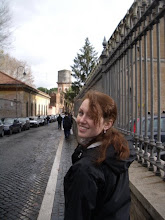The Virgin Mary is a very important figure in Italy, in both a religious and practical way. While the Catholicism of Rome is a variable thing (some are martyrs, some are Borgia popes, and most people oscillate between those extremes), Mary is constant. She is there when they baptize the Roman babies (and the Sicilian, and the Florentine, and all the Italian babies, for that matter) in an elaborate ceremony that revolves around a pampered infant in a frilly dress, who probably won't remember any of it, and she is there when those infants grow up and get married (another elaborate ceremony involving a frilly dress; the Italians seem to really love them). When people are trying to have children, they go write notes to the Virgin and leave them at the feet of her
statues. When those children, a few years later, fall off a playground, their mothers call on Mary again for help. She is not just for children and mothers, however; grown men invoke her name when they see a beautiful woman walking down the street (their eyes bug out and they yell 'maDONNA', with a great flourish and serious emphasis on the 'donna' part.)
In return for this constant work, however, Mary gets a few perks, and one of them, currently in process here in my lovely Trastevere, is a huge festival devoted to her. There are many Marys in Rome, but this festival is the Celebrazioni per la Festa della Madonna del Carmine, better
known in English as Our Lady of Mount Carmel, friend to the Carmelites. Technically, her feast
day is the 16th of July, but since 1996 (and I know this because there is a plaque put up by John Paul II on the church) there has been a big festival in this area that lasts for 10 days, the last of which was yesterday.
On the first day of her festival, they dress the large (almost life sized) statue of the Virgin in a beautiful dress (she gets a new one every year, though they always look the same) and a m
assive crown, and they put in her hands something called 'scapulars'. (A side story: it took me ages to figure out what these were called, because all the people I asked were too busy yelling to enunciate properly...) Having looked it up later, I found that while a scapular refers to the monk's cloak, which goes over the shoulders and covers the front and the back, what our Mary was holding is a devotional scapular, which in her case is a small rectangle of wood with a beautiful
silver overlay. She holds four of them, two in each hand, with her initials and a portrait of her with the baby Jesus on them.
Having dressed her up for the occasion, the population of Trastevere all crams into San Crisogono for mass, and then the statue is lifted up on a platform and processed around the neighborhood. For the occasion, some streets are decorated with Christmas lights. And there were masses of people waiting for the Virgin to appear. When she did, she was announced by a man on a loudspeaker, who sang (quite well, actually) Schubert's Ave Maria. When he was done, her procession moved up the street, and people were yelling her name and applauding. This is a picture of her being carried by the Carmelite monks, but that man's head got in the way of my camera flash:

Here you can see her processing up the street with all the Christmas lights:

She ends up in another church, Sant' Agata, where she stayed until this morning. At that point, as far as I can tell, she is sprited off to someplace upriver, and there she waits, until the evening. This evening, Dara and I were wandering around Trastevere, unaware of the impending arrival of Mary (unaware, in fact, that she had left Sant' Agata), but when we got to Ponte Garibaldi, we saw not only that bridge lined with people holding candles, but the bridges as far down as Tiber Island, and the top of the Tiber embankments on both sides of the river as well. Not wanting to miss out, we collected some candles and elbowed our way to the front of the crowd, and waited. The sun started to go down, which makes a beautiful light at that exact point in Rome (more on this in another post), and people started to light their candles. Eventually, Mary appeared, still decked out in all her finery, on a boat, majestically moving down the river. When the boat reached Ponte Garibaldi, Mary, after disembarking, was once more carried on her platform and processed towards Santa Maria in Trastevere, possibly one of the top 5 most beautiful churches in Rome.
More yelling and cheering accompanied her, as did throngs of people holding lit candles, which was a bit of an adventure. When the statue and her followers reached Piazza Santa Maria in Trastevere, the bells of the church started to ring, and the statue was moved inside the church. At that point, there was a rush for tables at local restaraunts, and I could hear people thanking the Virgin when they managed to grab one of the prime, outdoor tables. The next day, in a much quieter and more solemn procession, Mary was returned to Sant' Agata and her festival garb removed, to face another year of being the go-to girl of Romans and Italians everywhere.
